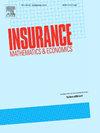Robust Nash equilibrium for defined contribution pension games with delay under multivariate stochastic covariance models
IF 2.2
2区 经济学
Q2 ECONOMICS
引用次数: 0
Abstract
This paper explores a stochastic differential investment game problem with delay among n defined contribution pension fund managers. These managers are concerned with relative performance and model ambiguity and participate in an incomplete financial market comprising a risk-free asset, a market index, and a stock. The market index and stock are described by a class of potentially non-Markovian multivariate stochastic covariance models, with the market prices of risks dependent on a multivariate affine-diffusion factor process. Managers' wealth processes are modeled by stochastic differential delay equations, considering performance-related capital inflow and outflow. Each manager aims to maximize the expected exponential utility of his terminal wealth with delay relative to the averages among his competitors under the worst-case scenario of the alternative measures and seek a robust investment strategy. By employing a backward stochastic differential equation approach to address this robust non-Markovian control problem, we derive, in closed form, the robust Nash equilibrium investment strategies, the probability perturbation processes under the well-defined worst-case scenarios, and the corresponding value functions. The admissibility of robust equilibrium policies is confirmed under specific technical conditions. Finally, we conduct numerical examples to demonstrate the impact of model parameters on robust investment policies and derive economic interpretations from the results.
多元随机协方差模型下具有延迟的固定缴费养老金博弈的鲁棒纳什均衡
本文研究了n个固定缴款型退休基金经理之间具有时滞的随机微分投资博弈问题。这些经理人关心的是相对绩效和模型模糊性,他们参与的是一个由无风险资产、市场指数和股票组成的不完全金融市场。市场指数和股票由一类潜在的非马尔可夫多变量随机协方差模型描述,其中风险的市场价格依赖于一个多变量仿射扩散因子过程。考虑与绩效相关的资本流入和流出,用随机微分时滞方程对管理者的财富过程进行建模。每个经理的目标是在替代措施的最坏情况下,最大化他的终端财富相对于竞争对手的平均水平的预期指数效用,并寻求稳健的投资策略。通过采用后向随机微分方程方法来解决这一鲁棒非马尔可夫控制问题,我们以封闭形式导出了鲁棒纳什均衡投资策略、定义良好的最坏情况下的概率摄动过程以及相应的值函数。在特定的技术条件下,证实了稳健均衡政策的可接受性。最后,我们通过数值例子来证明模型参数对稳健投资政策的影响,并从结果中得出经济解释。
本文章由计算机程序翻译,如有差异,请以英文原文为准。
求助全文
约1分钟内获得全文
求助全文
来源期刊

Insurance Mathematics & Economics
管理科学-数学跨学科应用
CiteScore
3.40
自引率
15.80%
发文量
90
审稿时长
17.3 weeks
期刊介绍:
Insurance: Mathematics and Economics publishes leading research spanning all fields of actuarial science research. It appears six times per year and is the largest journal in actuarial science research around the world.
Insurance: Mathematics and Economics is an international academic journal that aims to strengthen the communication between individuals and groups who develop and apply research results in actuarial science. The journal feels a particular obligation to facilitate closer cooperation between those who conduct research in insurance mathematics and quantitative insurance economics, and practicing actuaries who are interested in the implementation of the results. To this purpose, Insurance: Mathematics and Economics publishes high-quality articles of broad international interest, concerned with either the theory of insurance mathematics and quantitative insurance economics or the inventive application of it, including empirical or experimental results. Articles that combine several of these aspects are particularly considered.
 求助内容:
求助内容: 应助结果提醒方式:
应助结果提醒方式:


